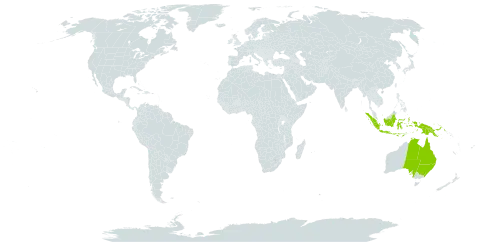Shrubs to small trees, up to 7 m high, often multistemmed. Indumentum of transluscent to yellow-ferruginous, simple hairs, glabrescent unless stated otherwise. Outer bark grey to brown, rough to flaky; inner bark streaky dark pink to red; cambium furrowed; sapwood pale amber, rather hard; heartwood dark pink. Stipules subulate, 1-1.8 by c. 0.3 mm, densely pubescent. Leaves: petioles 2-7 by 0.8-1 mm, (sub)glabrous to densely pubescent; blade elliptic, 1-9 by 0.45-3.2 cm, length/width ratio 2.2-2.8, base cuneate to truncate, margin crenate to serrate with 20-40 short teeth, apex obtuse to acute, strongly discoloured, upper surface dark glossy green, glabrous or with scattered hairs on the midrib; lower surface pale green, subglabrous; venation of 6-8 nerves per side, veins reticulate, indistinct. Inflorescences up to 10 mm long. Staminate flowers 2-3 mm diam., cream-yellow; pedicels 2.6-9 mm, glabrous; sepals orbicular to elliptic, 1-1.6 by 0.7-0.9 mm, glabrous; stamens 4 or 6, filaments 1.2-2 mm long, basally sparsely to densely hairy, anthers globose, 0.4-0.6 by 0.3-0.5 mm. Pistillate flowers 2.4-4.5 mm diam.; pedicels 1.5-2 mm long, with scattered hairs; sepals ovate to elliptic, 1.5-1.8 by 1-1.3 mm, glabrous or with scattered hairs; ovary usually 3-locular, subglobose, 1-1.5 by 2-2.5 mm diam., glabrous; stigmas 1.5-2.5 mm long, strongly recurved, papillose. Fruits globose, 4-7 by 5-11 mm diam., green-grey. Seeds ovoid, 3.5-4.8 by 2.5-3 by 2-3 mm thick, smooth, pale brown.
More
Shrub or small tree to 7 (–10) m high. Leaves: petiole 2–7 mm long; lamina elliptic to elliptic-lanceolate, 10–90 mm long, 4.5–32 mm wide, base cuneate to truncate, margin crenulate-serrate with 20–40 short teeth, tip acute or obtuse, venation comprising 6–8 lateral veins. Inflorescence up to 10 mm long. Male flowers 2.3–4 mm long, 2–3 mm diam.; pedicels 2.6–9 mm long; sepals orbicular to lanceolate, 1–1.6 mm long, 0.7–0.9 mm wide. Female flowers 2–3.5 mm long, 2.4–4.5 mm diam.; pedicels 1.5–2 mm long; sepals lanceolate-ovate, 1.5–1.8 mm long, 1–1.3 mm wide; ovary 1–1.5 mm long, 2–2.5 mm diam.; styles 1.5–2.5 mm long. Fruit globose, 4–7 mm long, 5–11 mm diam.
Grows in heathland, open forest, vinethickets and vineforest, usually on sandy soils.

